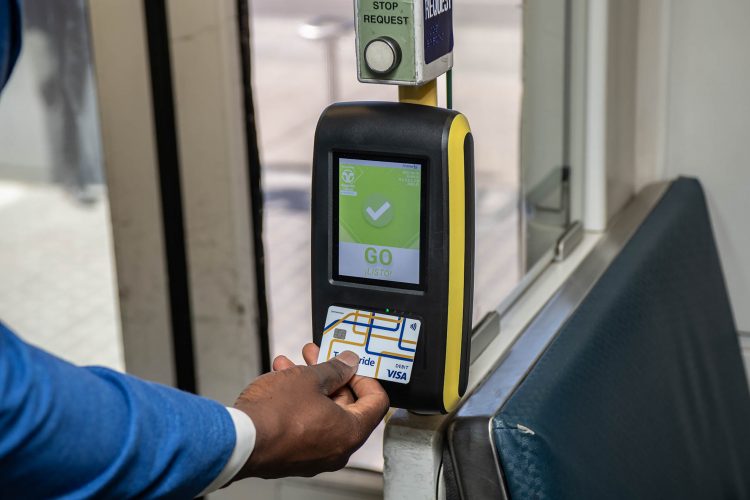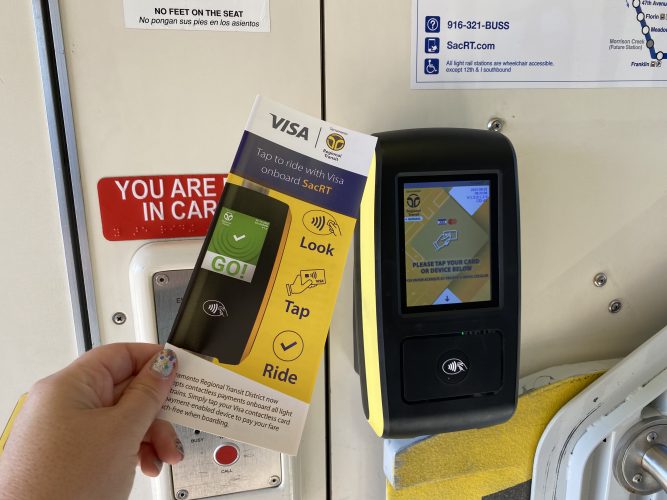California taps into the future of fare collection
- Like
- Digg
- Del
- Tumblr
- VKontakte
- Buffer
- Love This
- Odnoklassniki
- Meneame
- Blogger
- Amazon
- Yahoo Mail
- Gmail
- AOL
- Newsvine
- HackerNews
- Evernote
- MySpace
- Mail.ru
- Viadeo
- Line
- Comments
- Yummly
- SMS
- Viber
- Telegram
- Subscribe
- Skype
- Facebook Messenger
- Kakao
- LiveJournal
- Yammer
- Edgar
- Fintel
- Mix
- Instapaper
- Copy Link
Posted: 11 January 2022 | Gillian Gillett - California Department of Transportation | No comments yet
Gillian Gillett, Program Manager of California Integrated Mobility at the California Department of Transportation, outlines the agency’s vision for a connected transportation network in California, which will offer riders contactless payments and better journey information.


Credit: California Department of Transportation - Toks Omishakin, Director of the California Department of Transportation (Caltrans), taps a debit card on an open-loop payment acceptance device.
The phrase “transportation in California” likely evokes images of vast tangles of freeway, the crimson contours of brake lights threading from desert to ocean. It’s true, the car is king in California. Cars account for more than eight out of 10 of the state’s commutes, while solo drivers make up three out of four. The result? Poor air quality, mind-numbing traffic and inadequate ways for carless Californians to get around.
Within this context, California has set ambitious objectives for sustainability, mobility and equity, and has positioned public transit as the cornerstone of its agenda to achieve these targets. But getting car-reliant Californians to park their cars and board a bus is no mean feat.
That’s why the California Department of Transportation (Caltrans) is trying a new approach to transit planning: think less like government and more like tech, and design transit that works for everyone.
To get there, in 2019, Caltrans hatched the California Integrated Travel Project (Cal-ITP), the state’s new incubator for mobility innovation. As a team of veterans from the technology and transportation industries, Cal-ITP is working with transit providers across the state to make riding transit an easy, intuitive and predictable experience that puts riders at the heart of transit planning.
To kick things off, we conducted a market sounding with a broad cross section of industry representatives for input on how California should improve the rider experience and increase transit’s mode share. Rather than the usual response from a handful of speciality vendors, the kickoff event saw front row seats occupied by heavy hitters from the payments and mobility industries, including PayPal, Visa, Mastercard, Google and Uber. Here’s what we learned:
- California’s 300+ transit providers build and plan in silos. This lack of standardisation makes it impossible to invest in solutions that scale, resulting in bespoke systems that are not interoperable for either providers or riders
- Innovation and standardisation in the banking and payments industries mean that legacy transit fare systems will not compete well.
The solution: unify transit across California with a single, interoperable payment system and real‑time data standard to make transit easier to use and more appealing to both new and regular riders. Specifically, Cal-ITP is crisscrossing the state to achieve the following three objectives:
- Enable open-loop contactless payments: adopt the global contactless Europay, Mastercard, Visa (cEMV) standard as the state’s primary fare payment technology so that riders can quickly and easily tap to pay using their smartphone or the bank card that’s already in their wallet.
- Automate customer discounts: streamline the process for riders to instantly qualify for and receive transit discounts (ie senior, veteran, student) when they tap to pay, regardless of which transit system in the state they use.
- Standardise information for easy trip planning: remove the guesswork for riders wondering when the next bus or train will arrive by using the General Transit Feed Specification Realtime (GTFS-RT), the global standard for publishing real-time transit information, including fares and payment methods.
Creating a marketplace
When it comes to interoperability in transit, conceiving a system and building it are two entirely different matters. It’s essential that we make it as easy and affordable as possible for all transit providers – regardless of their budget or staff capacity – to procure the technologies that they’ll need. To that end, Cal-ITP has developed the California Mobility Marketplace1, an online catalogue of code-compliant products and services that transit providers will need in order to start using contactless fare collection and real-time GTFS data.
Cal-ITP is working with transit providers across the state to make riding transit an easy, intuitive and predictable experience”
The Mobility Marketplace takes an innovative approach to public procurement. Rather than having individual transit providers fend for themselves on the open marketplace to find the right technologies, it gathers and presents links to a suite of pre-negotiated, code-compliant products and services. This means that nearly all of the procurement work has already been done. For each product and service, Caltrans has already identified or advanced an RFP and leveraged the purchasing power of the State of California to negotiate deeply discounted rates with the selected vendors. All transit providers need to do is choose which products and services work best for them and sign on to existing contracts. This approach saves providers time and money and enables any agency, even those with little to no procurement experience, to design and purchase their own fare collection systems.


Cal-ITP teamed up with Visa and other private sector partners to bring transit riders the ability to tap to ride Sacramento Regional Transit District light rail.
Will it work?
While seamless payments and standardised data may be new to California, transit systems across the globe have been serving their riders with these systems for years, so we know the benefits to riders are manifold. With a uniform, global fare payment system and real-time data standard, Californians can expect to see the following:
An improved rider experience
Real-time data standards save riders time waiting at a transit stop. One study in Seattle showed that riders with access to real-time data shaved two minutes off of their wait times, while perceiving waits to be 30 per cent shorter. Contactless payments also make riding transit easier, particularly for out-of-towners and other unfamiliar riders. New York has seen credit card taps from over 130 countries, while two-thirds of London riders converted to contactless after just their first use.
More riders on transit
The speed and convenience of open-loop payments and the trip-planning advantages of real-time arrivals data together lure riders to transit. London saw a four to five per cent growth in Underground ridership in its first year of contactless fare collection, while real-time data grew bus ridership in Chicago and New York by two per cent.
While seamless payments and standardised data may be new to California, transit systems across the globe have been serving their riders with these systems for years, so we know the benefits to riders are manifold”
Cost savings for transit providers
Accepting cash is expensive, but going contactless can cut costs significantly. For example, Washington, D.C. spends 10 cents per dollar on cash-based fare collection but just four cents on each dollar collected through credit/debit cards.
Lower greenhouse gas emissions
In addition to the environmental benefits of shifting more travellers to transit, contactless fare collection also decreases dwell time, meaning less time spent idling. In fact, the Transportation Research Board found that it takes the average rider about half as long to board when tapping to pay than when paying cash or swiping a fare card.
Equitable access to transit
Contactless fare collection enables fare capping, meaning that riders can benefit from the savings of unlimited ridership without shelling out the upfront costs of an unlimited-ride pass. Moreover, automated discounts ensure that eligible riders will pay the right fare every time, regardless of where in California they ride. Finally, keeping in mind that nearly a quarter of Californians are un/underbanked, Cal-ITP is working with payment networks to create financial accounts for those who do not already have one, enabling all transit riders to tap a debit card to pay for transit.
Learning lessons at home
We know that contactless fare collection and real-time data deliver tangible results, both for transit riders and for a desired mode shift to transit. But we also know that California – the world’s fifth-largest economy, with one in four residents born abroad and nearly half speaking a language other than English – is a unique entity unto itself. While we can learn from other places, our most valuable lessons have to come from our own streets.
So, to both prove and iterate our concept, we’re working with partner agencies around the state to launch demonstration projects and gather learnings from real-world experience. First, in May 2021, Monterey-Salinas Transit (MST) became the state’s first transit provider to accept contactless payments on its fleet of buses, followed by Sacramento Regional Transit’s (SacRT) Green Line becoming the state’s first light rail trains to go contactless in June 2021.
In both cases, over a six-month period, we’ll continue to work closely with each agency to collect data, connect with customer service and listen to riders to adapt our approach. For example, we’re looking at potential changes to fare policies, marketing and rider education, troubleshooting with device and service vendors, contactless adoption rates among riders, mobile connectivity and more. As a result, each subsequent transit system should enjoy a more seamless experience transitioning to open-loop fares and standardised GTFS data.
What’s next?
We’ve laid the groundwork for a modernisation of public transit in California; now’s the time to make it happen on a state-wide scale. We at Cal-ITP will spend the coming months working closely with hundreds of transit providers to help them to evaluate their data quality and devise strategies for achieving full GTFS-RT coverage.
We’ll continue to contract with technology vendors to make sure transit providers have their pick of top-notch products at affordable rates. We’ll make sure messaging to riders effectively communicates how and why their commutes will be getting easier, and we’ll launch additional demonstration projects to hone our methods and to make sure that transit becomes a reliable, convenient and natural travel choice for anyone in California. Someday soon, we’ll hear the phrase “transportation in California” and visualise an image not of soul-crushing congestion but of the 21st century transit system that Californians deserve.
Gillian Gillett manages California Integrated Mobility programmes – such as the California Integrated Travel Project (Cal-ITP) – for the California Department of Transportation (Caltrans), which researches, designs and implements solutions to make it easier to find, plan and pay for mobility in California, beginning with transit. Previously, Gillett was Transportation Policy Director for San Francisco Mayor Edwin M. Lee, focusing on high-speed rail, regional bike sharing, Caltrain electrification and transportation revenue measures. Prior to working for Mayor Lee, Gillett was a business process and workflow consultant to the financial services sector.
Related topics
Accessibility, Infrastructure & Urban Planning, Passenger Accessibility, Passenger Experience, Public Transport, Ticketing & Payments, Transport Governance & Policy, Travel & Passenger Information
Issue
Issue 3 2021
Related modes
Bus & Coach
Related countries
United States
Related organisations
California Department of Transportation (Caltrans)
Related people
Gillian Gillett








